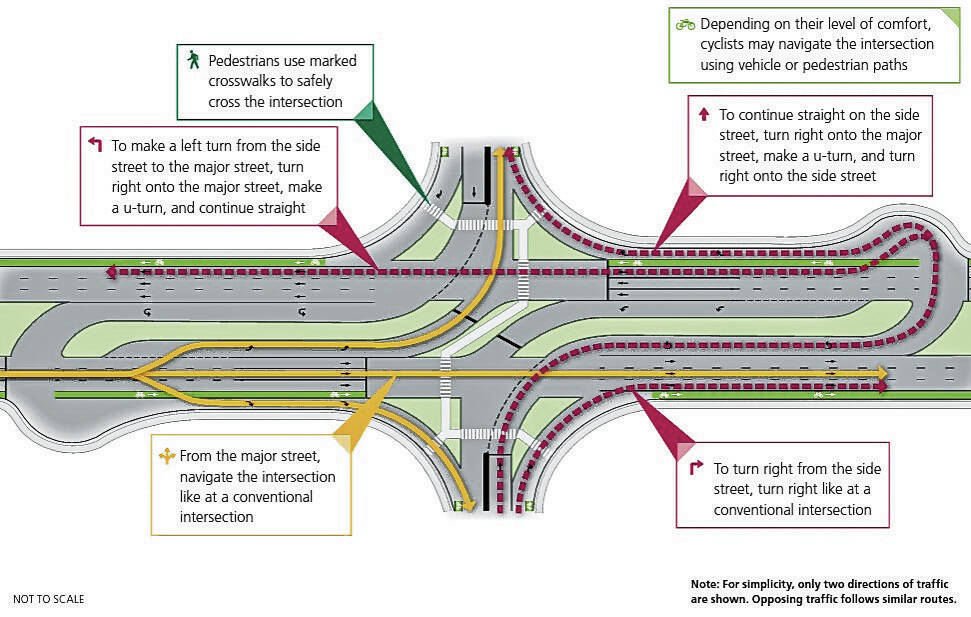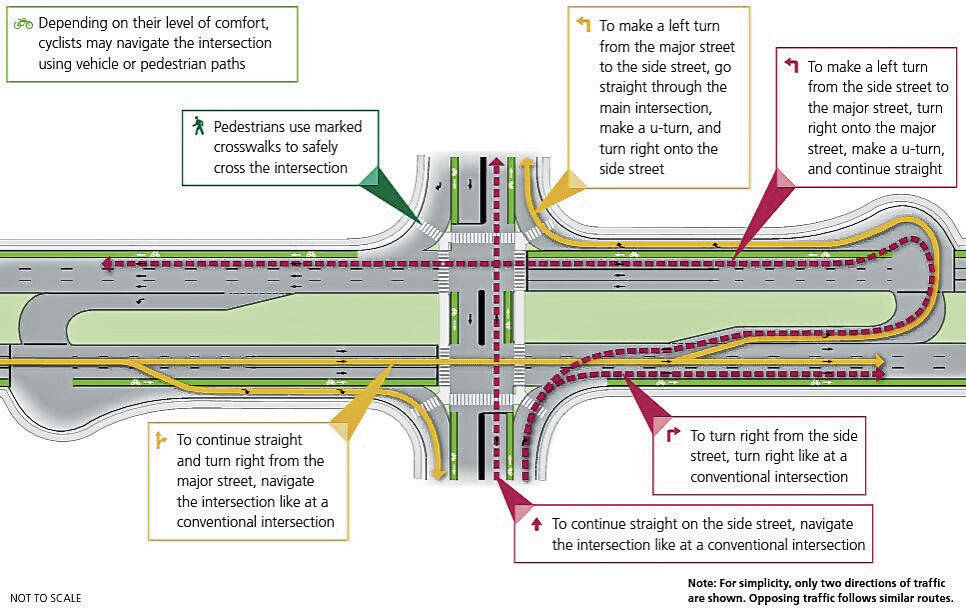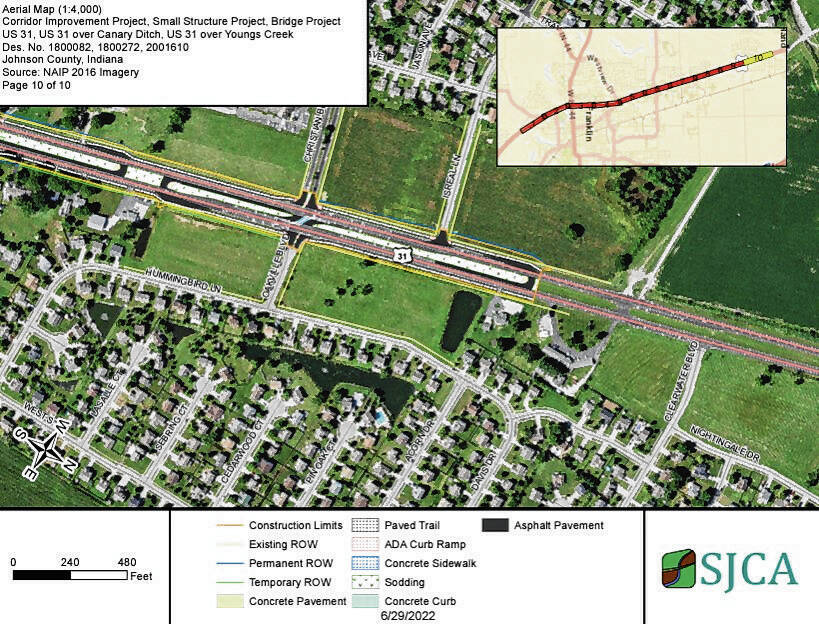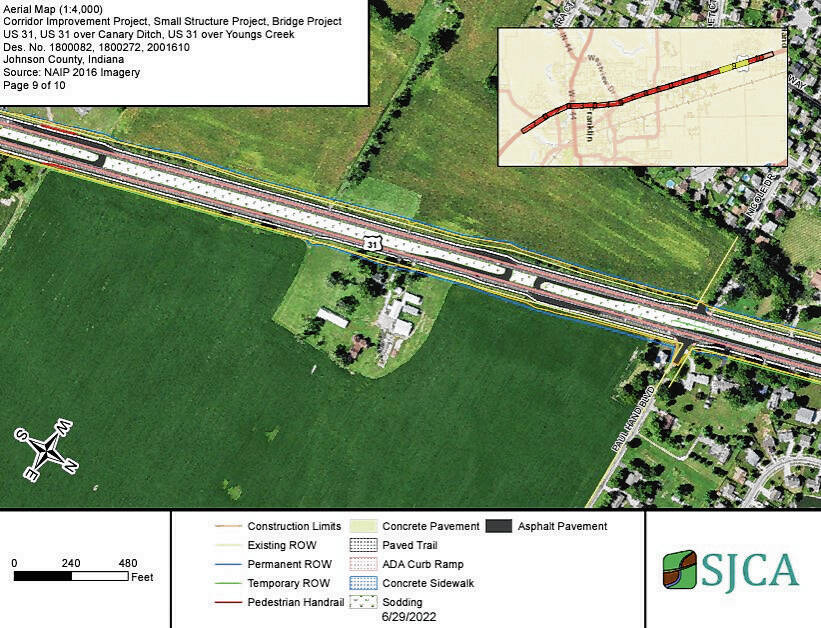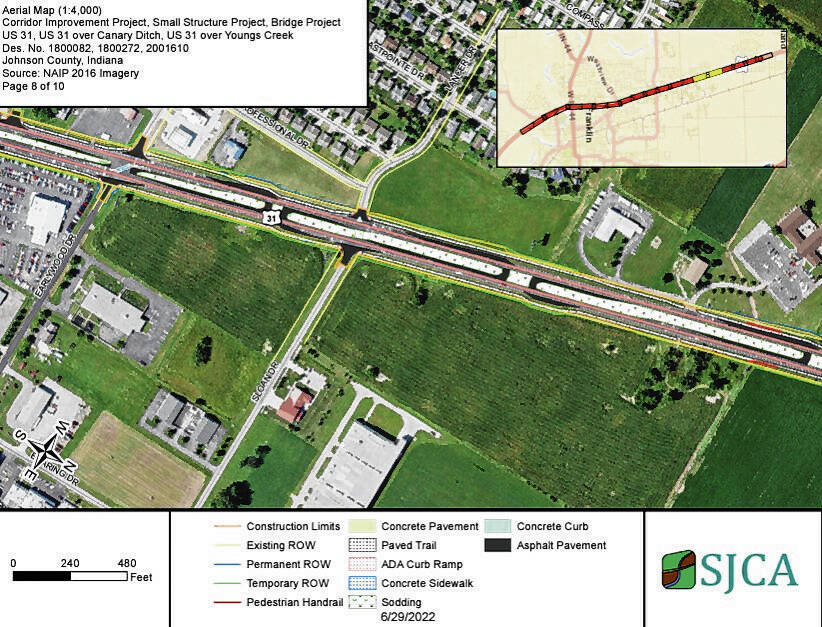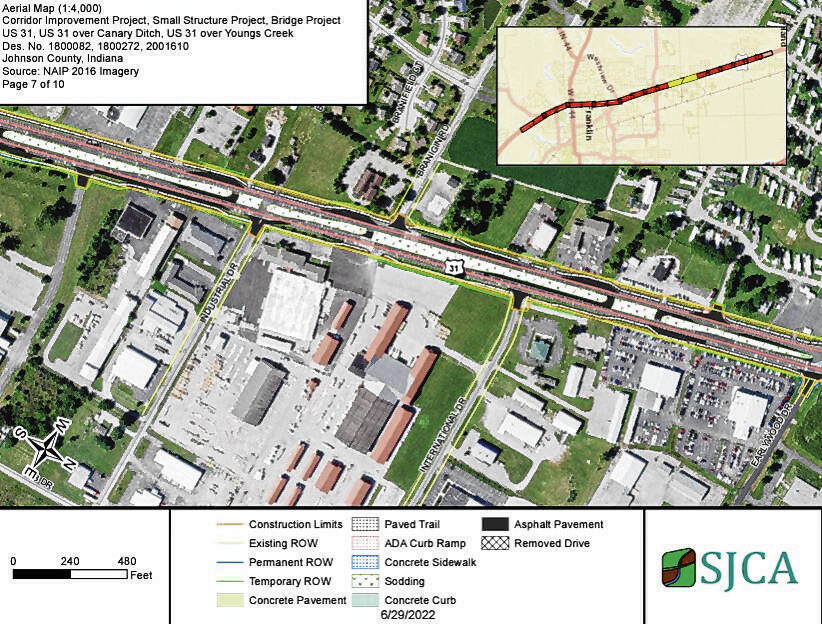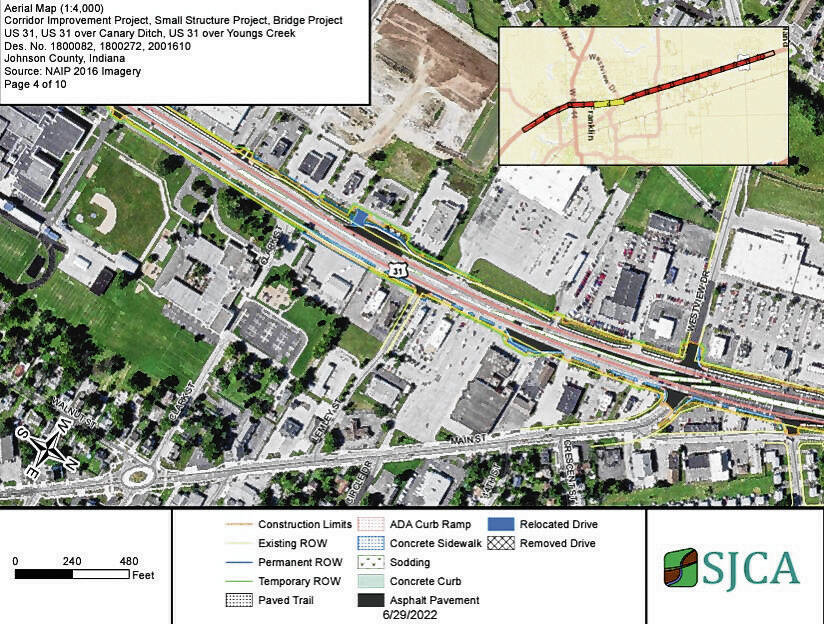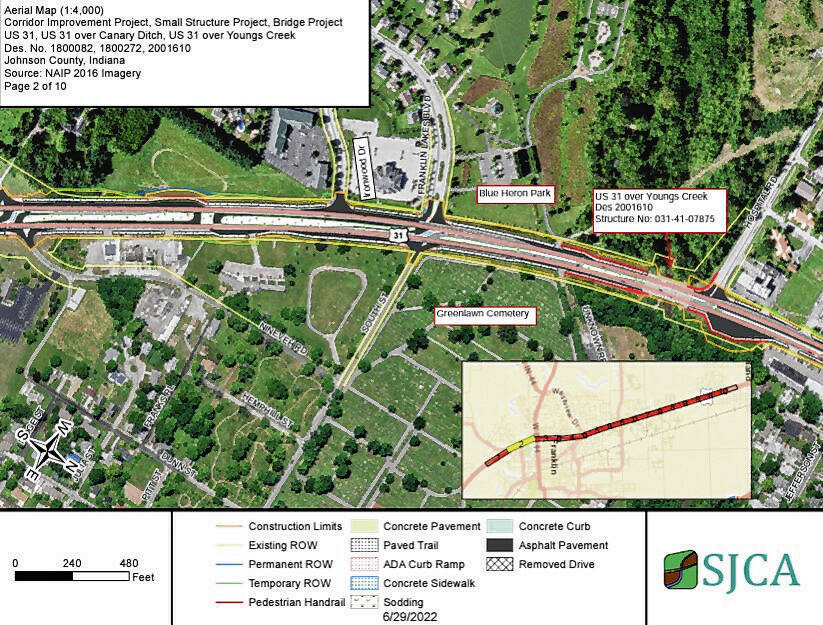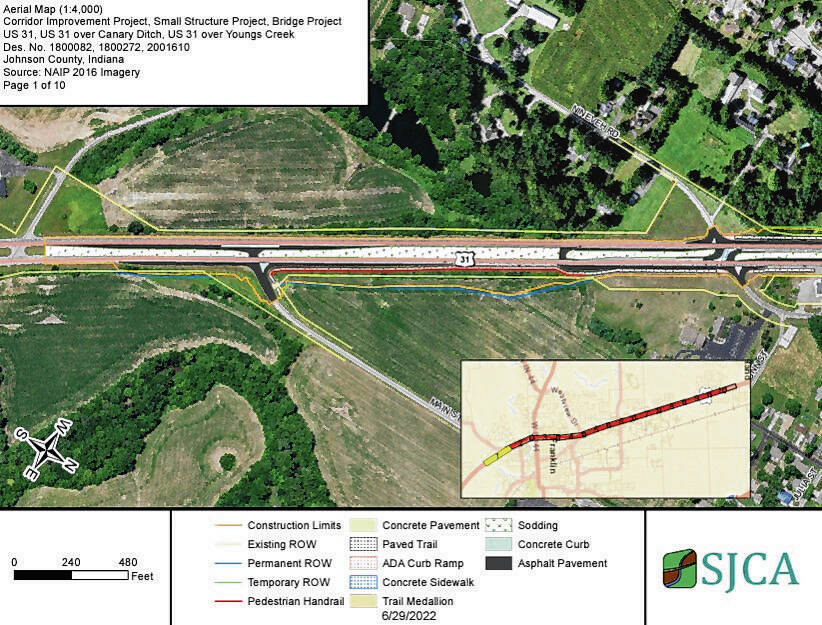Local residents can give input Monday on a nearly $42 million project that would bring an entirely new streetscape including Michigan lefts and multi-use paths to U.S. 31 in Franklin.
The Indiana Department of Transportation, CrossRoads Engineers and SJCA Inc. are hosting a public hearing at 6:30 p.m. Monday for the proposed project along U.S. 31/Morton Street in Franklin at the Franklin Community Middle School Auditorium. The meeting will provide an opportunity for the public to learn more about the project, view displays, ask questions and make comments on the project, INDOT officials say.
What’s changing
The project would remove the ability to cut directly across U.S. 31, which has been the source of hundreds of accidents on the road. Instead, the project would construct a long series of reduced conflict intersections, including restricted crossing U-turns, commonly known as Michigan lefts.
Jefferson Street would be unchanged by the project, but all other streets between the southern end of South Main Street and Israel Lane will be changed in some way by the project.
The project would construct R-CUT intersections at Nineveh Road, Franklin Lakes Boulevard-South Street, King Street, Mallory Parkway, Westview Drive-North Main Street, Earlywood Drive, and Christian Boulevard-Oakville Boulevard. A Continuous Green T- intersection is planned at U.S. 31 and South Main Street, while MUT intersections would be constructed at all other intersections on U.S. 31 in Franklin.
An R-CUT intersection is designed for all side street movements to begin with a right turn, so motorists who need to turn left or go straight would make a U-turn at a dedicated median opening. A MUT is a type of intersection where left-turn vehicles from one or both roads make U-turns at dedicated median openings to complete the desired movement, according to a description from the Virginia Department of Transportation.
For the South Main Street Continuous Green T-intersection, traffic from South Main Street and northbound U.S. 31 would be controlled by a signal, while traffic on southbound U.S. 31 flows freely, INDOT officials say.
In addition to the intersection changes, a bridge replacement at Canary Ditch and drainage improvements are planned, along with multi-use trails on both sides of the highway and new curb ramps that are compliant with the Americans with Disabilities Act, INDOT officials say.
The purpose of the project is to reduce congestion, improve traffic flow, improve pedestrian connectivity and increase safety along U.S. 31 in Franklin. INDOT and the city worked closely on the design to further the city’s goals of connecting the retail and residential areas on U.S. 31 to downtown with trails, said Steve Barnett, Franklin’s mayor. The trail will run the length of the project and intersect with the city’s current trail system, he said.
The city was first approached about the roadwork by INDOT and officials decided to use this opportunity to accomplish the trail project, Barnett said. The city council contributed $3.5 million for the engineering of the trails because pedestrian connectivity on U.S. 31 was something that city officials had been working toward for years, he said.
City officials didn’t give input on the design of the road, but Barnett said safety improvements are needed. He’s been told the Franklin stretch of U.S. 31 is the most dangerous section of U.S. 31 between Indianapolis and Columbus.
“This is going to be different, but it is going to be safer,” Barnett said.
Another benefit to city residents is drainage improvements that are planned for Canary Ditch, Barnett said. This is expected to relieve flooding that impacts subdivisions that are built within the watershed of the ditch, he said.
Why it’s needed
The new intersection designs have been controversial on social media and several have written to the Daily Journal with questions about the project.
People are expressing concerns that confusion over the new intersections could cause accidents and that semis won’t be able to safely make a U-turn while others are balking at the inconvenience of not being able to cut across U.S. 31.
INDOT officials say while these types of intersections are still relatively new in Indiana, they are proven to reduce accidents, particularly fatal accidents. These types of intersections have been built on U.S. 30 in Allen and Whitley counties, U.S. 231 in Spencer County and on U.S. 41 in Newton County.
Since construction, fatal and injury crashes in those areas have been reduced by an average of 81%, property-damage crashes are down by an average of 58% and all crashes have decreased by an average of 68%, according to data from INDOT. Nationally, statistics show crashes reduce by at least 50% where reduced conflict intersections are installed and fatal crashes decline by as much as 85%.
While it is not a specific priority to install these intersections throughout the state, INDOT officials plan to install them in any place where engineers determine they could help reduce accidents, said Natalie Garrett, INDOT spokesperson. That was the case for other areas where the intersections have been built and that is the case for Franklin.
These intersections reduce accidents by reducing the number of potential conflict points where vehicles could collide, Garrett explained. Four-direction, signalized intersections have a total of 32 potential vehicle conflict points, with 16 of those being points in the intersection where right-angle, or T-bone and left-turn crashes are possible. However, R-CUT and MUT intersections have many fewer conflict points, at 14 and 12, respectively, she said.
An INDOT review of crash history revealed a total of 697 crashes between 2014 and 2016, with 156 of those being personal injury crashes. The most common types of crashes were rear-ended and right-angle, so by eliminating left turns and through movements at most intersections, INDOT officials expect crashes to reduce in Franklin.
More recent data from the Franklin Police Department reveals there have been more than 210 accidents on U.S. 31 over the past five years.
In Fall 2020, INDOT shut down a crossing point that was among the most dangerous, Simon Road, by installing barriers that prevent cross traffic. Schoolhouse Road, Christian Boulevard, Paul Hand Boulevard and Westview Drive are other areas of U.S. 31 where accidents occur often, Franklin police data shows.
The intersections are being designed for peak travel times and will be large enough to accommodate semi-trucks, Garrett said. As part of the project, several asphalt aprons called traffic loons are being built where traffic can cross over via the U-turn lane. The traffic loons are placed there to make sure semis can make their turn without damaging the side of the road, she said.
The intersections could also reduce traffic congestion and shorten travel times.
“Where already in place, these types of intersections have proven to reduce travel times and congestion, and improve overall traffic flow,” Garrett said. “This is due in part to a simplified intersection where traffic is not waiting through multiple signal phases to get a green light. Instead, they are waiting for gaps in traffic to make movements.”
Project timeline
Construction is expected to start next spring and be completed in phases over the course of the next two years. The project will begin with replacing the bridge over Canary Ditch, and in summer 2023 the project will move south to begin reconstructing the road at the southern end of the project, from South Main Street to the bridge over Youngs Creek, according to a timeline from INDOT.
Crews will move north from South Main Street for the duration of the project, with work at the northern part of the project, from Sloan Drive to Israel Lane to begin in summer 2025, INDOT officials say.
Lanes of traffic will shift during the project but the road will not be fully closed at any point, Garrett said. Driveways to businesses and residential areas will also be kept open, she said.
Before all that begins though, the public has a chance to comment on the project.
For the public hearing on Monday, doors will open at 6 p.m. to allow the public time to view displays and ask INDOT officials questions.
A formal presentation by INDOT officials will begin at 6:30 p.m.
Questions and comments may be submitted in person at the hearing or via email to Victoria Veach with SJCA Inc. at [email protected]. All comments on the project should be submitted by the close of business on Aug. 15.
Additional project information is also posted on INDOT’s Seymour District webpage.


